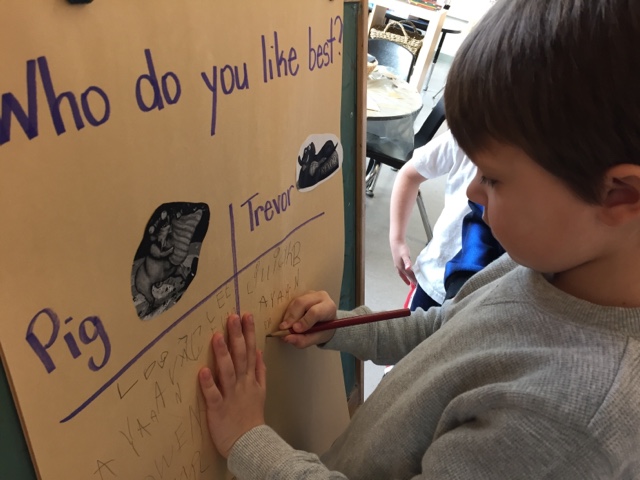I am a Reggio Emilia inspired Full Day Kindergarten teacher and mother to three young children. This blog is meant as a communication tool for the families of our children and as a learning tool for the many educators who follow us. Please feel free to comment on posts and participate in our collective understanding of emergent curriculum.
Friday, February 26, 2016
Snack Survey
We try to embed math and literacy into every center. Today the children spent time discussing and then voting for our favourite character from the book "Pug the Fibber" when visiting snack.
Thursday, February 25, 2016
Maker art
We had a maker art center today where children had the opportunity to design their own stamp and explore printmaking.
We offered sticky foam and cardboard.
The children cut the foam into shapes and stuck it on a cardboard base.
The children then painted the stamp and pressed it on paper to see what print it made.
One child noticed that the stamp of her name's initial stamped backwards on the paper.
She problem solved by designing her brother's initial backwards so it looked correct when stamped.
Maker spaces encourage children to build and explore with loose parts. We can't wait to see what else is created here tomorrow!
Composing 10
We've been spending a lot of time this week working with snap cubes to help us think about different ways of making ten. A game we like to play is 'Hide 10'. Mrs. McLennan holds up 10 cubes. She then hides some behind her back. Children look at the remaining cubes and guess how many are hiding. Recognizing the number of cubes builds subitizing skills and thinking about how many might be hiding reinforces mental math and addition abilities.
We wanted to encourage children to record these ideas on paper so that they could further their understanding and think about how these math ideas looked in an equation.
Wednesday, February 24, 2016
Fill 100
We played a partner game to build subitizing, counting and adding skills today. You need a friend, dice, grid paper and crayons to play.
Each player takes a turn rolling the dice, identifying the numbers and adding them together to get a total.
Each player then has a turn colouring the corresponding number of squares on the grid to match the sum of their roll.
Players take turns until the grid is filled. The player with the most squares coloured at the end of the game wins.
Tuesday, February 23, 2016
Colour Mixing Paint Trays
At the art center we offered the children trays of white paint with red, yellow and blue. Water was used to clean the brushes in between use.
We encouraged children to experiment with combining various colours of paint in order to make their own unique shades.
It was interesting to hear the math talk that emerged in this activity as the children discussed the quantity of paint and how much of and how many colours were used in the experimentation.






















































